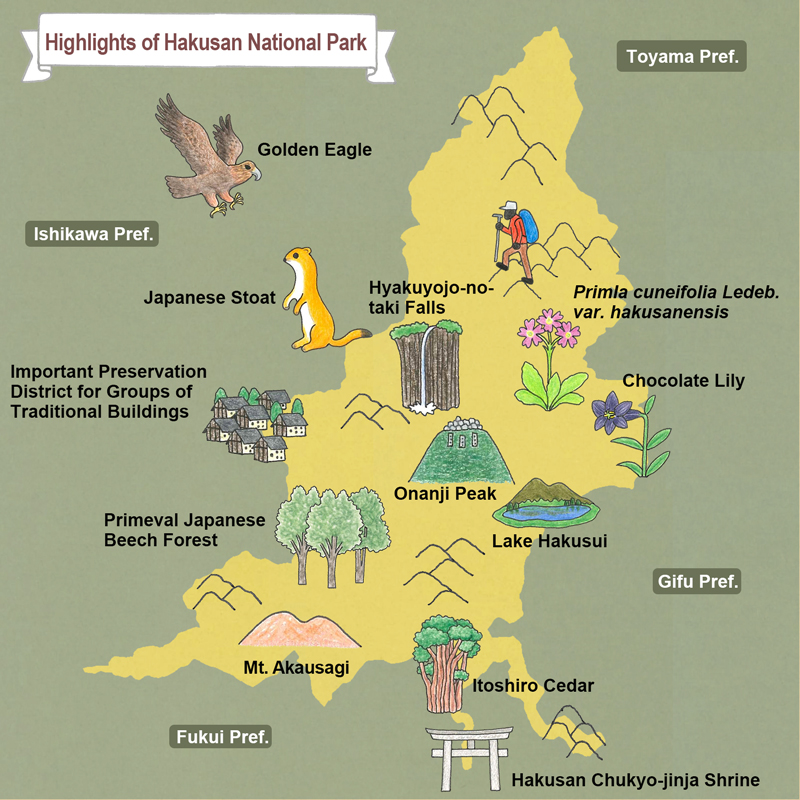- MOE
- National Parks of Japan
- Hakusan National Park
- Guide of Highlights
main body
Highlights of Hakusan National Park
Important Preservation District for Groups of Traditional Buildings

Important Preservation District for Groups of Traditional Buildings
Shiramine Village has created its own unique culture from the harsh natural environment, which has some of the heaviest snowfall in Japan. With houses concentrated on narrow river terraces, the townscape is rare, even amongst Japan's mountain villages.
Hyakumangan Rock (Designated as a Natural Monument of Ishikawa Prefecture)
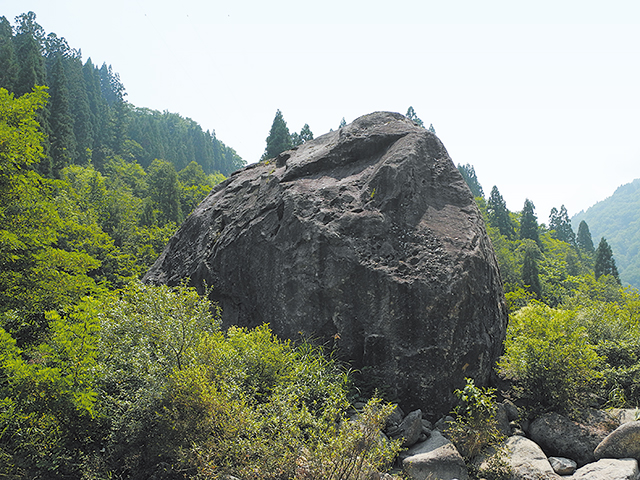
Hyakumangan Rock (Designated as a Natural Monument of Ishikawa Prefecture)
This enormous rock was washed down a Tedori River tributary from Miya-dani in the great floods of 1934 that wrecked immense damage on the Tedori River area. The rock is so named because it has been said to probably weigh as much as hyakuman-gan (3.75 million kilograms).
Mt. Akausagi
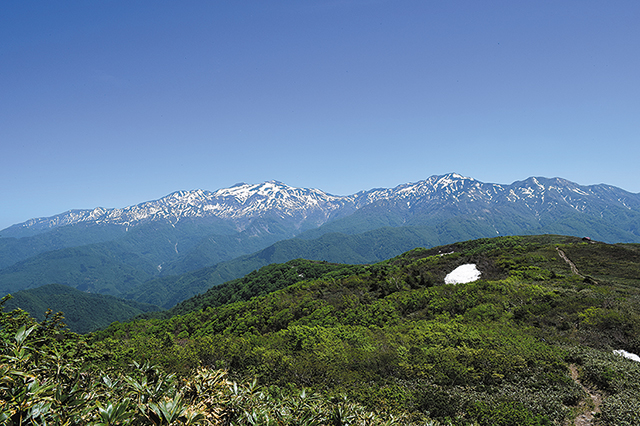
Mt. Hakusan as Viewed from the Peak of Mt. Akausagi
Mt. Akausagi
The peak of Mt. Akausagi provides stunning close-up views of not only Mt. Hakusan but also Mt. Arashima, Mt. Ocho, and other sights. The Akausagi Plateau is a wet grassland with marshes where flowers such as daylilies and Lilium japonicum can be enjoyed in summer.
Iwayamatadani Hiking Site
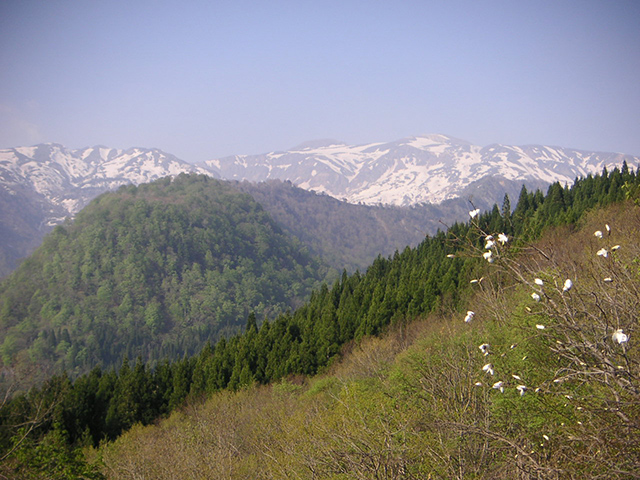
Mt. Hakusan as Viewed from the Hakusan Observatory
Iwayamatadani Hiking Site
After climbing up the nature observation trail from Ichinose hiking site for approx. 20 minutes, a magnificent view of all the main peaks of Mt. Hakusan is easily obtained from the Observation deck. Climb for a further 40 minutes to reach the Panorama Observatory, where a panoramic view of Mt. Hakusan can be enjoyed.
Japanese Beech Forest (Primeval Forest)
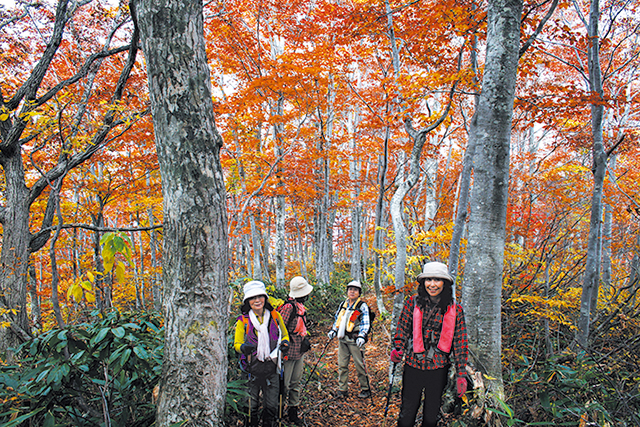
Crimson Leaves of the Japanese Beech Forest in
Autumn
Autumn
Japanese Beech Forest (Primeval Forest)
Climbing the Bessan-Ichinosedo trail from Ichinose hiking site for approx. 2 hours, you arrive at Chiburi Ridge, one of the few areas of primeval Japanese beech forest in the Mt. Hakusan area. Nature observation meetings are conducted in spring, when the leaves are fresh green, and in autumn, when the leaves turn red.
Zenjodo Trails
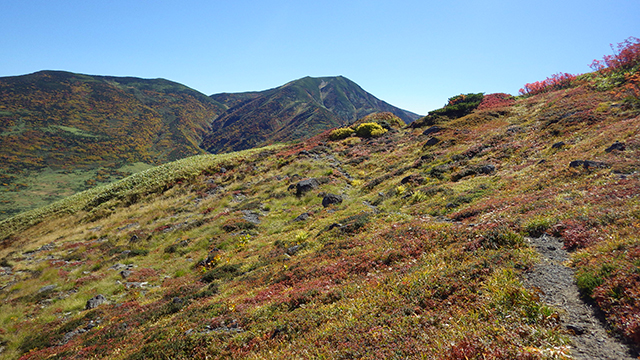
Zenjodo Trails
In the past, there were three Zenjodo (pilgrimage trails) leading from Three banba to Mt. Hakusan: Echizen-Zenjodo, Kaga-Zenjodo, and Mino-Zenjodo. Each of these roads is still used today as sections of mountain trails.
Onanji Peak
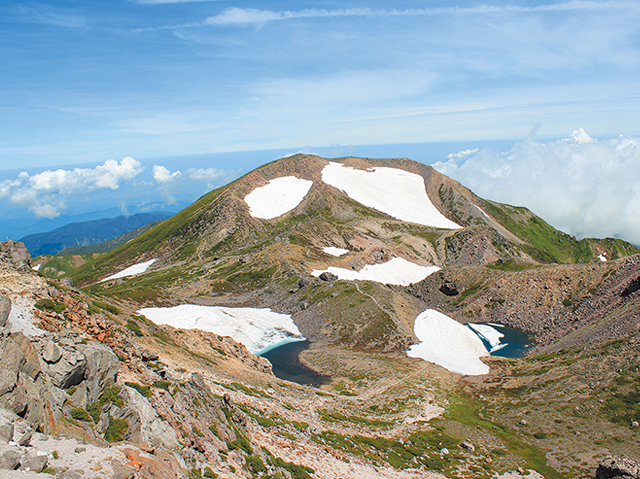
Onanji Peak
Forms the peak of Mt. Hakusan, together with Gozengamine and Kengamine. The Onnanji-jinja Shrine is built at the peak (2,684 m above sea level) in view of Gozengamine, Kengamine, and Lake Midorigaike.
Tour-around-the-Ponds
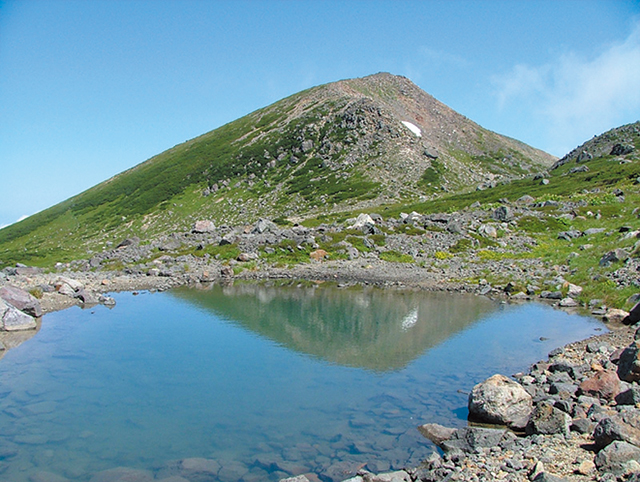
Onanji Peak as Viewed from Goshiki Pond
Tour-around-the-Ponds
Starting in Murodou, the course visits Mt. Hakusan's highest peak, Gozengamine, then seven large and small crater lakes and ponds dotted around the summit area.
In summer, full-time nature guides at the Murodou Center conduct nature observation meetings.
Hyakuyojo-no-taki Falls
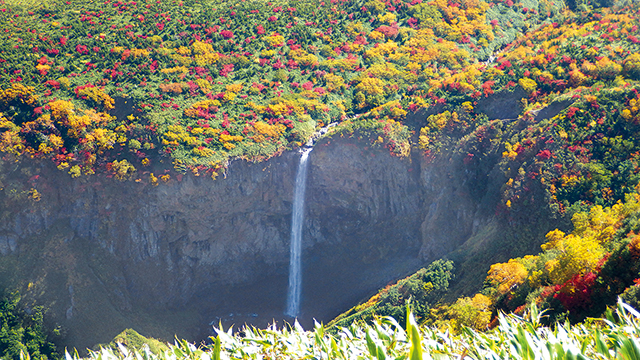
Hyakuyojo-no-taki Falls
This waterfall with a vertical drop of approx. 90 m is one of the most eminent landscape element in Mt. Hakusan area. The falls can be viewed from above from the Kaga-Zenjodo Ridge. The sight of the falls rushing over the edge of the vast Seijougahara Plain can be said to be one of the most dynamic landscape views in Mt. Hakusan.
Itoshiro Cedar (Designated as a National Special Natural Monument)

Itoshiro Cedar (Designated as a National Special Natural Monument)
A short way up the Mino Zenjodo (Itoshiro trail) from the mountain entrance from Itoshiro in Gujo City, Gifu Prefecture, is the fifth largest Cedar tree in Japan. The trunk measures 13.45 m around, and it takes 12 adults to encircle it, hence the name Juni-kakae no Osugi ("Giant Cedar Encircled by 12 People").
Hakusan Chukyo-jinja Shrine

Hakusan Chukyo-jinja Shrine
This long-established Shinto Shrine is in Itoshiro in Shirotori, Gujo City, Gifu Prefecture, a place known since ancient times as the home of the gods. Thus it is a core shrine for followers of Mt. Hakusan worship, which spread across Japan.
Gigantic Japanese cedar trees over 1,300 years old line the approach to the shrine, creating a dignified atmosphere.
Lake Hakusui
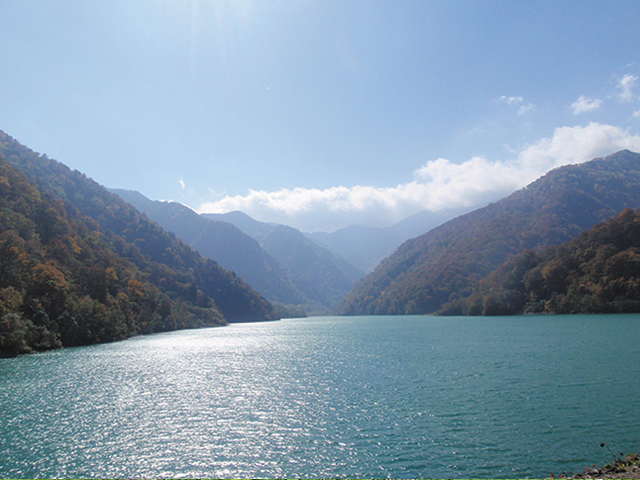
Lake Hakusui
The color of this artificial lake changes with each season. The primeval Japanese beech forest of Oshirakawa reflected in the emerald green surface creates an air of mystery, and the views of Bessan and the main peaks of Mt. Hakusan from the lake are breathtaking.
Activities
Mountain Climbing

Mountain Climbing
Mt. Hakusan has been known as a mountain for devotions since ancient times. For this reason, the Senjo Path, a path for ascetic practices and meditative concentration since ancient times, still remains, while various mountaineering tracks such as the new erosion-control track frequently used by mountaineers (Ishikawa Prefecture) and the Hirase Track (Gifu Prefecture) have been maintained in Toyama, Ishikawa, Fukui, and Gifu Prefectures.

Summit of Gozengamine
There are various appealing mountain climbing trails on Mt. Hakusan.
Area close to the mountaintop
• Tour-around-the-Ponds Course (Murodou-Gozengamine-Midori-ga-ike Pond)
• Eco-Line trail
• Tembo-hodo trail
Area close to the mountaintop
• Tour-around-the-Ponds Course (Murodou-Gozengamine-Midori-ga-ike Pond)
• Eco-Line trail
• Tembo-hodo trail

Lake Hakusui as Viewed from the Hirasedo
Ishikawa Area
• Ichinose hiking site --Iwayamatadani hiking site--Panorama Observatory
• Jadani Nature trail
• Betto-deai trailhead--Sabo-shindo/Kanko-shindo--Murodou
• Northern mountain trails (Kaga-Zenjodo, Rakuraku-shindo, Iwamado, Chugudo)
• Ichinose hiking site --Iwayamatadani hiking site--Panorama Observatory
• Jadani Nature trail
• Betto-deai trailhead--Sabo-shindo/Kanko-shindo--Murodou
• Northern mountain trails (Kaga-Zenjodo, Rakuraku-shindo, Iwamado, Chugudo)

Sannomine
Gifu Area
• Hirasedo trail (Hirase trailhead--Mt. Okura-Murodou)
• Mino-Zenjodo (Itoshiro trailhead-- Choshigamine--Sannomine)
• Hirasedo trail (Hirase trailhead--Mt. Okura-Murodou)
• Mino-Zenjodo (Itoshiro trailhead-- Choshigamine--Sannomine)
Fukui Area
• Kamikoike-Karikomiike nature trail/Sannomine Trekking Course
(Kamikoike Car Park--Ropponhinoki-- Kengaiwa--Sannomine)
• Mt. Akausagi/Mt. Ocho Trekking Course
(Ohara trailhead--Ohara Pass-- Mt. Akausagi/Mt. Ocho )
• Kamikoike-Karikomiike nature trail/Sannomine Trekking Course
(Kamikoike Car Park--Ropponhinoki-- Kengaiwa--Sannomine)
• Mt. Akausagi/Mt. Ocho Trekking Course
(Ohara trailhead--Ohara Pass-- Mt. Akausagi/Mt. Ocho )

Ogasayama Shelter Hut
Toyama Area
• Mt. Ogasa Trekking Course (Lake Katsura--Tennomata--Mt. Ogasa Trekking Course)
• Mt. Nara Trekking Course (Bunao Pass--Mt. Akamakiko--Mt. Naradake)
• Mt. Ogasa Trekking Course (Lake Katsura--Tennomata--Mt. Ogasa Trekking Course)
• Mt. Nara Trekking Course (Bunao Pass--Mt. Akamakiko--Mt. Naradake)
Wildlife & Plants
Primla cuneifolia L.var. hakusanensis

Primla cuneifolia L.var. hakusanensis
One of the approximately 20 varieties of plants taking the name "Hakusan (Mt. Hakusan)." In Japanese, it is called "hakusankozakura" or "sakura originating from Mt. Hakusan" and is found between the subalpine and alpine zones in colonies in snowy valleys and on grasslands. Blooms in July and August. Found in colonies at Minamiryuugabanba, etc. on Mt. Hakusan.
Chocolate Lily (Fritillaria camschatcensis)
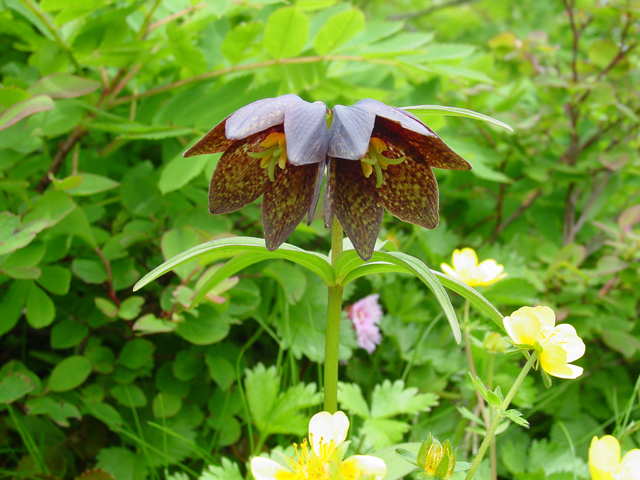
Chocolate Lily (Fritillaria camschatcensis)
Grows on grasslands between the subalpine and alpine zones in the Chubu region and further north. Since there are no mountains with alpine zones west of Mt. Hakusan, it forms the western limit for the chocolate lily, and for other alpine plants. Large colonies can be seen in the area around Murodo, and at Ohanamatsubara.
Golden Eagle (Aquila chrysaetos japonica)

Golden Eagle (Aquila chrysaetos japonica)
A large bird of prey found in mountainous regions from Hokkaido to Kyushu. The golden eagle at the top of the food chain is a symbol of the lush natural environment of the Hakusan National Park. The Chugu Onsen Visitor Center (Chugu Museum) and the Mt.Bunao Observation House are recommended.
Japanese Stoat (Mustela erminea nippon)
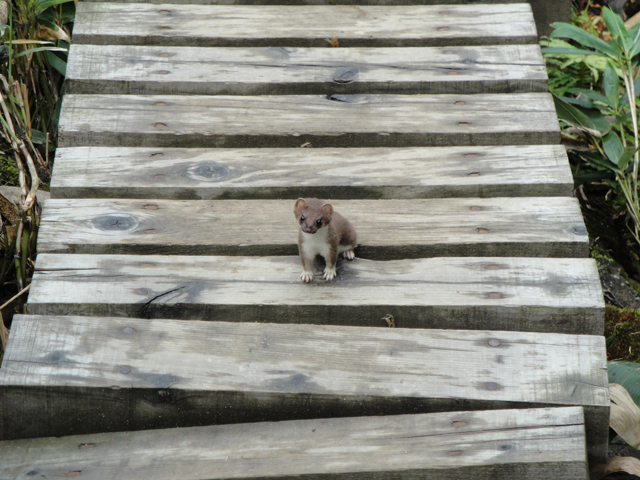
Japanese Stoat (Mustela erminea nippon)
A species of the weasel family found in the Chubu region and further north. Carnivorous. Eats small mammals such as rats and moles, birds, and sometime the larger hare. Often seen on wood pathsbetween Minami-ryuugabanba and the peaks.
